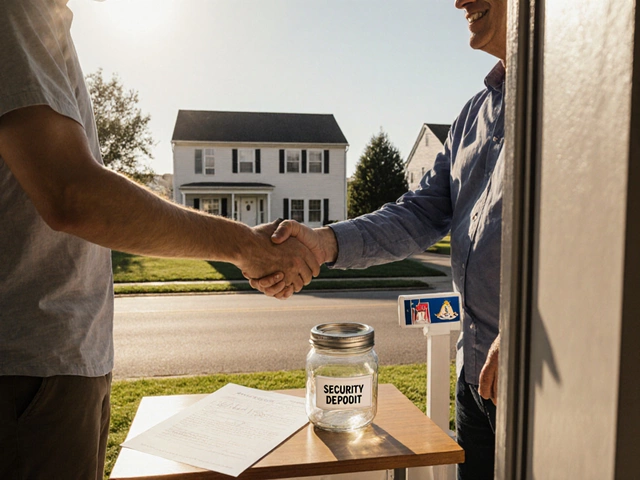Your house was worth more last year—what’s going on? This isn’t just happening to you. Plenty of homeowners are scratching their heads watching their property value slip, even when they didn’t do anything different. Home values don’t just drop out of nowhere; usually, it’s a mix of factors. Sometimes you can fix it, sometimes you can’t.
First thing to check: are homes in your area selling for less lately? Real estate prices are like a roller coaster and can turn fast, especially if you’re tracking everything online these days. Your neighbor’s bargain sale, a new building going up, or some fresh potholes popping up on your street can all play a part.
If you just noticed your home value dipping in an online estimate or appraisal, it pays to look closer at what’s really moving the numbers. Some things are way beyond your control (think: mortgage rates or economic talk on the news), but sometimes, small stuff at home can make your price slide faster than you’d think. Stick around to find out what causes these drops, and more importantly, what you can do about it.
- The Market’s Mood Swings
- What’s Happening in Your Neighborhood
- How Online Buying Changes the Game
- Hidden Factors Knocking Down Value
- Smart Moves to Bounce Back
The Market’s Mood Swings
Here’s the deal: the real estate market has a mind of its own. Sometimes values are shooting up, and other times, the air just goes out. If you’ve seen your home value drop, chances are the market’s on a downswing, not just your place taking a hit.
What moves these ups and downs? The big players are:
- Interest rates: When mortgage rates go up, buyers pull back because their monthly payments get tougher. Fewer buyers means homes don’t sell as fast or for as much. After the sharp rate hikes in 2023 and 2024, buyer demand slipped all across the country.
- Inventory: More homes for sale compared to buyers drags values down. If lots of new properties hit your area’s listings, prices often get competitive—in the wrong way for sellers.
- Local job market: If big employers lay off or move out, folks don’t want to buy, and sellers cut prices to attract the few who do.
- Media panic: News of a recession or "housing bubbles" can make people nervous, leading buyers to hold back and slowing down the whole market.
Don’t just take my word for it. Check out how the numbers have shifted:
| Year | US 30-Year Mortgage Rate (%) | Annual Home Price Growth (%) |
|---|---|---|
| 2022 | 3.5 | +18 |
| 2023 | 7.5 | +2 |
| 2024 | 6.9 | -1 |
| 2025 (so far) | 6.8 | -0.5 |
See that? Just a couple years ago, home prices were skyrocketing. Mortgage rates doubled, and now price growth is sliding—some places even in reverse. If you’re buying property online or checking prices every week, these swings are easy to spot now, not months later.
If your home value’s down, it’s rarely just about your house. It’s more about timing and what everyone else is doing. This is why sometimes waiting it out works better than rushing to sell when the dip hits.
What’s Happening in Your Neighborhood
Your home doesn’t exist in a bubble. What goes on around you often packs a bigger punch than anything inside your four walls. Buyers pay close attention to what’s trending in your zip code. If there’s a rise in crime, changes in school ratings, or new developments no one’s happy about, your property value drops quicker than you’d expect.
Look at crime rates first. In 2024, data from the National Association of Realtors showed a 12% drop in property values in areas where crime reports doubled within a year. Even a few break-ins on your street can scare off first-time buyers searching online.
Next up: schools. Real estate sites spotlight school ratings because buyers follow them like a checklist. Home values can swing up or down by as much as 10% if local schools move a letter grade. Imagine your neighborhood school slipped from a B to a C last year—expect a dip in home value to follow.
Major construction matters, too. If a new highway or factory goes up near your place, noise and pollution turn buyers away. Even that ‘coming soon’ shopping center can hurt if it brings more traffic than perks.
- Home value drops if many homes sit unsold. Too many “For Sale” signs signal weak demand and that pushes prices down.
- Foreclosures hit hard. When banks repossess homes and sell cheap, your area’s average sale price tanks and drags your property value lower.
- New amenities can help. Parks, cafés, or better public transport can lift home value, but empty lots or run-down shops have the opposite effect.
Check out how a few factors can stack up in your neighborhood:
| Neighborhood Factor | Typical Impact on Home Value (%) |
|---|---|
| Crime Rate Spike | -8 to -15% |
| School Rating Drop | -5 to -12% |
| Many Unsold Homes | -3 to -10% |
| Major Construction (highway, factory) | -7 to -18% |
| New Park or Transit Option | +4 to +8% |
The bottom line? Keep an eye on the neighborhood—what’s going up, what’s being torn down, and who’s moving in or out. Sometimes just being the first to know can help you react before your property price does.

How Online Buying Changes the Game
Buying and selling homes online used to sound risky. Now, it’s pretty much the norm. People scroll through virtual tours, click on mortgage calculators, and lean hard on sites like Zillow or Redfin for their price checks. But here’s the kicker—these online platforms can move home value up or down in ways you probably don’t expect.
First, online estimates use algorithms. They pull in data from recent sales, neighborhood trends, and even photos. But if one house sells low because the owner needed fast cash, or if no info shows up for upgrades you’ve made, the estimates might tank your home's value—even if your place is way better off than the one next door.
It’s not just about estimates. The entire buying process sped up. Homes can list, get offers, and even sell without buyers ever visiting in person. This means buyers sometimes rely on “average” trends instead of noticing the special things about your place—like your cool landscaping or that kitchen update nobody sees in a filter.
- Instant buyers (iBuyers): Companies like Opendoor or Offerpad buy homes quickly, often below market value. Their activity can set a new low price benchmark if they keep buying in your area.
- More price transparency: Everyone can see recent sales and asking prices with a few clicks. But if your neighbors drop their price, yours might look overpriced in comparison, forcing you to go lower.
- Automated appraisals: Banks and websites are using data instead of on-site visits to set values. They miss upgrades and often don't catch unique features, so values can skew down.
Here’s a look at how much the online world influences home prices. In a 2024 study by the National Association of Realtors, 97% of buyers said they used the internet in their home search, and 50% found their actual home there first before contacting an agent.
| Factor | Influence on Price |
|---|---|
| Online Valuation Tools | Quick value swings |
| iBuyer Sales | Usually set a lower price point |
| User-uploaded Listings | Can make your listing look stale if it sits too long |
Bottom line: the shift to online buying means your home isn’t just competing with your block—it’s on display next to every house like it. When the market gets tough, the algorithms and iBuyers can pull prices down even if your place deserves more. Knowing how these online moves work can help you get ahead of the game.
Hidden Factors Knocking Down Value
Plenty of stuff can nibble away at your home value without you even noticing. These aren’t just big headline news events—sometimes it’s the stuff you find out during a casual chat with a neighbor or in your local Facebook group.
- Home value takes a hit if there’s deferred maintenance. Leaky roof, aging HVAC, or even a broken fence out front? Buyers and online estimates both see those as warning signs.
- Bad smells (think pets, mold, or lingering food) hurt property prices. A study in 2023 showed listings mentioning odors saw up to 22% fewer online views.
- Nearby foreclosures or empty houses make your home less attractive. Lenders use these as ‘comps’ (comparable sales) even if your property is in great shape.
- Low energy efficiency, like old windows or poor insulation, can knock prices down. In 2024, 67% of millennial buyers said they’d pay less for a home with high utility bills.
- Outdated interiors—carpet in the bathroom, old appliances, or faded paint—show up in photos on online platforms and push your home down in search results.
Here’s a look at just a few hidden value-changers and their impact:
| Hidden Factor | Possible Value Impact |
|---|---|
| Mold Issues | Lower by 10-20% |
| Unkempt Landscaping | Lower by 5-12% |
| Noisy Neighbors | Lower by 3-8% |
| Major Repairs Needed | Lower by 10-25% |
| Old Electrical Systems | Lower by 5-10% |
Sometimes, even things just outside your fence line—like a new cell tower or a nearby noisy bar—can put off potential buyers. If you see your value slide, don’t just blame the market. Check these sneaky issues first because small upgrades or repairs can sometimes stop the drop before it gets worse.

Smart Moves to Bounce Back
So, your home value took a hit—don’t just watch it sink. There are practical steps you can take to give your property a boost, both short-term and long-term. Every bit helps, especially when buyers do most of their research and shopping online. Here’s where you can get your hands dirty and actually see results.
First, focus on curb appeal. Simple things like a trimmed lawn, fresh paint, or a fancy-looking mailbox can lift buyer interest. According to a 2023 study by HomeLight, homes with boosted curb appeal sold for an average of 7% more than similar homes without upgrades. If you have a tired front yard or peeling paint, start there.
Don’t ignore maintenance. Small issues—leaky faucets, squeaky doors, or busted appliances—may seem minor but can knock down appraisals fast. Fix what you can. For bigger upgrades, choose what counts: most folks get their money back (sometimes even more) for minor kitchen and bathroom facelifts.
Getting an energy audit helps too. Swapping old bulbs for LEDs, adding insulation, or sealing drafty windows can make your house look more attractive and help new owners save money. As of 2024, homes with energy-saving upgrades sell about 10 days faster on average.
If you’re serious about bouncing back, take advantage of online tools. Get a real-time estimate from several real estate sites, but don’t trust just one. Compare, and if you’re seeing a trend, ask a local agent for a second opinion. They follow the home value market every day and can help you focus on upgrades or pricing strategy that really matters where you live.
Below is a useful breakdown of which projects give the best bang for your buck based on a national 2024 remodeling report:
| Improvement | Average Cost | Average Return (%) |
|---|---|---|
| Minor Kitchen Remodel | $15,000 | 71% |
| Garage Door Replacement | $4,500 | 94% |
| Landscaping/Curb Appeal | $3,000 | 68% |
| Bathroom Remodel | $12,000 | 58% |
Don’t forget to check your tax record and home listing info on sites like Zillow or Redfin. Sometimes, the square footage or features are listed wrong, which can drop your online estimate. Fixing basic errors can raise your displayed value without spending a penny.
If things feel overwhelming, look for a real estate agent who really knows your block. The right advice will save time and maybe even money. Remember, bouncing back from a dip isn’t always quick, but small wins stack up. Every upgrade or fix can make your place more appealing online and off, setting you up for a better payday.






